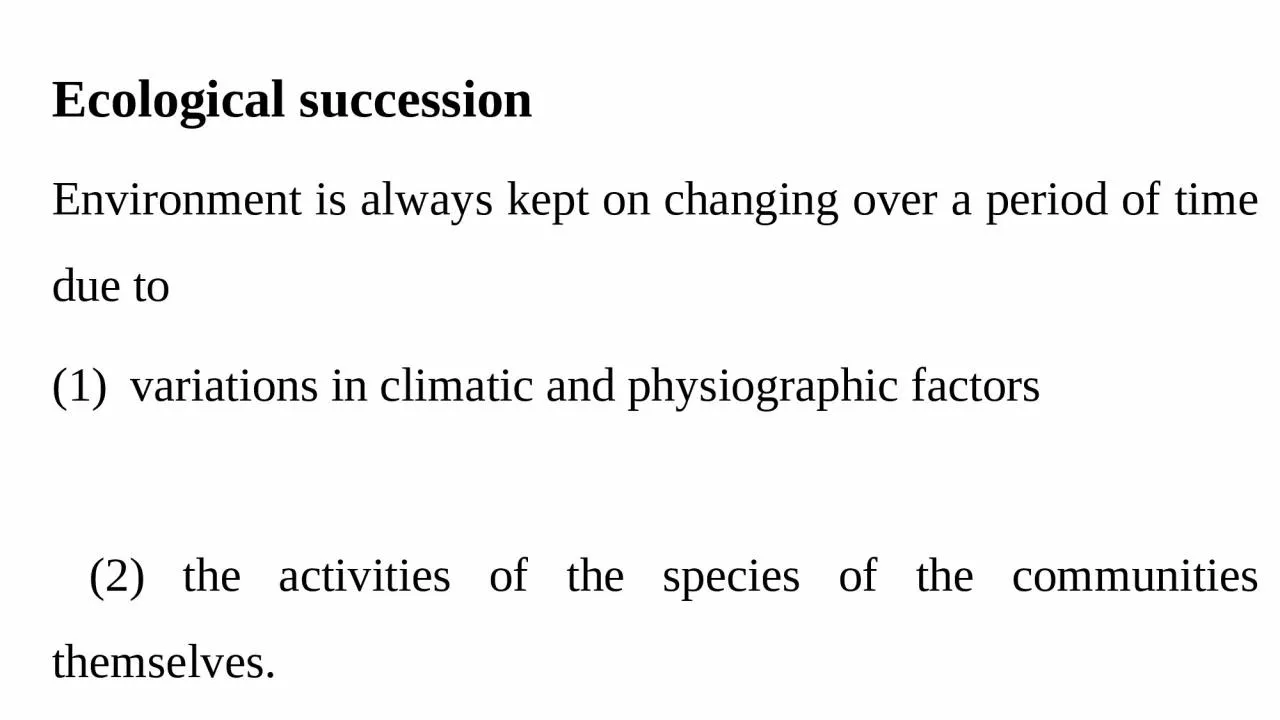

variations in climatic and physiographic factors 2 the activities of the species of the communities themselves These influences bring about marked changes in the dominants of the existing community which is thus sooner or later replaced by another community at the same place This process co ID: 1025846
Download Presentation The PPT/PDF document "Ecological succession Environment is alw..." is the property of its rightful owner. Permission is granted to download and print the materials on this web site for personal, non-commercial use only, and to display it on your personal computer provided you do not modify the materials and that you retain all copyright notices contained in the materials. By downloading content from our website, you accept the terms of this agreement.
1. Ecological successionEnvironment is always kept on changing over a period of time due to variations in climatic and physiographic factors (2) the activities of the species of the communities themselves.
2. These influences bring about marked changes in the dominants of the existing community, which is thus sooner or later replaced by another community at the same place. This process continues and successive communities develop one after another over the same area until the terminal final community again becomes more or less stable for a period of time. It occurs in a relatively definite sequence. This orderly change in communities is referred as succession. Odum called this orderly process as ecosystem development/ecological succession.
3. Succession is an orderly process of community development that involves changes in species structure and community processes with time and it is reasonably directional and therefore predictable. Succession is community controlled even though the physical environment determines the pattern.
4. Characteristics of successionAn ecological succession is characterized by:(a) A continuous change in the kinds of plants and animals towards a state of stability.(b) Tendency towards increase in the species-diversity.(c) An increase in the organic matter and biomass supported by available energy flow in(d) Decrease in net community production or annual yield.(e) In an area, the plant and animal communities undergo succession side by side.(f) Biotic succession is according to specific laws and towards particular direction so futureseral communities can be predicted.(g) Biotic succession on bare ground progresses towards increasing wetness, while bioticsuccession in open water progresses towards increasing dryness. autotrophic succession.
5. Causes of succession Succession is a series of complex processes, caused by Initial/initiating cause: Both climatic as well as biotic. Ecesis/continuing process ecesis, aggregation, competition reaction etc. Stabilizing cause: Cause the stabilization of the community. Climate is the chief cause of stabilization and other factors are of secondary value.
6. Types of succession Primary succession: Starts from the primitive substratum where there was no previously any sort of living matter. The first group of organisms establishing there are known as the pioneers, primary community/primary colonizers. Very slow is the series of community changes that takes place in disturbed areas that have not been totally stripped their soil and vegetation.
7.
8. 2. Secondary succession: Starts from previously built up substrata with already existing living matter. Action of and external force, as a sudden change in climatic factors, biotic intervention, fire etc., causes the existing community to disappear. Thus area becomes devoid of living matter but its substratum, instead of primitive is built up. Such successions are comparatively more rapid.
9.
10.
11. 3. Autogenic succession: Community - result of its reaction with the environment, modified its own environment and thus causing its own replacement by new communities. This course of succession is autogenic succession.
12.
13. 4. Allogenic succession: Replacement of the existing community is caused largely by any other external condition and not by the existing organisms. 5. Autotrophic succession: Characterized by early and continued dominance of autotrophic organisms like green plants. Gradual increase in organic matter content supported by energy flow.
14. 6. Heterotrophic succession: Characterized by early dominance of heterotrophs, such as bacteria, actinomyces, fungi and animals. There is a progressive decline in the energy content.
15. General Process of succession (i) Nudation: Development of barren area without any form of life. Cause of nudation: It may be (a) Topographic soil erosion by wind (b) Climatic - storm, frost etc. (c) Biotic - man, disease and epidemics. (ii) Invasion: Successful establishment of a species in a barren area. This species actually reaches this new site from any other area by (i) Migration, (ii) Ecesis and (iii) Aggregation.
16. Retrogressive succession: Continuous biotic influences have some degenerating influence on the process. Due to destructive effects of organisms, the development of disturbed communities does not occur. Process of succession, instead of progressive, it becomes retrogressive. (Eg.) Forest may change to shrubby or grassland community.
17. Deflected succession: Sometimes due to changes in local conditions as soil character or microclimate the process of succession becomes deflected in a different direction than that presumed under climatic conditions of the area. Thus the climax communities are likely to be different from the presumed climatic climax community.